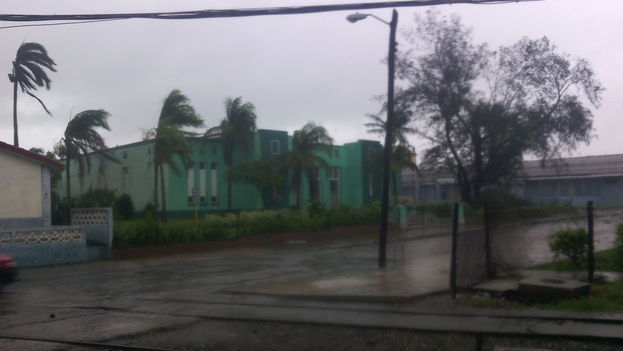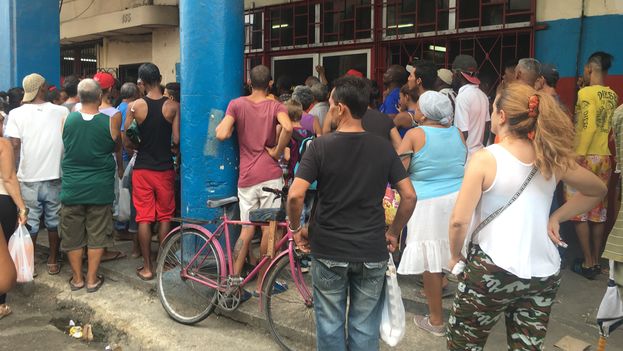
![]() 14ymedio, Havana, 8 September 2017 — Hurricane Irma advanced through the archipelago north of the province of Camagüey early this morning, where it touched land in Cayo Romano on Friday night with winds up to 160 miles per hour.
14ymedio, Havana, 8 September 2017 — Hurricane Irma advanced through the archipelago north of the province of Camagüey early this morning, where it touched land in Cayo Romano on Friday night with winds up to 160 miles per hour.
Irma is the first category 5 hurricane whose eye has touched Cuban territory since 1932. On Saturday morning, its maximum sustained winds fell and it became a category three hurricane on the Saffir Simpson scale. Its expanse affected the entire national territory.

In the municipalities of Esmeralda and Chambas the rains and the winds have been felt strongly since the dawn of this Saturday and according to reports of the local radio the 13 evacuation centers with the territory of Camagüey are crowded.
The president of the Government in Camagüey, Isabel González Cárdenas, informed the official media that in the town of Esmeralda there are “severe damages to roofs and facades of state institutions and private houses, fallen trees, breaks in the electrical service, and partial and total building collapses.”

As it passes through the province of Camagüey, Irma is causing damage in almost all municipalities.
The slum area popularly called La Fabela in the Bobes neighborhood west of Camagüey was flooded as the waters of the San Pedro River overflowed, but many residents refused to be evacuated for fear of being prevented from returning to their homes.
“There was no way to prepare for this,” said Liset Ávila, 28, who lost all her belongings when the river began to flood. “The wind was terrifying, but what did the most damage was the water, I’ve lost everything,” she laments.
A few yards away, Rafael Suárez does not regret having stayed despite the fact that he can barely move through the water. “I did not evacuate because these houses are illegal and it was very likely that we would not be allowed to return,” he told this newspaper. “Now we only have to wait for the water to go down and start rebuilding what was left.”
For Irma Cáceres what happened is as unfortunate as it is unprecedented. “I’ve never seen such a disaster,” she says, and heading down the street in search of her house of which she can barely see the roof.

René Fernández Quiroga, a resident of Santa Cruz del Sur, told this newspaper that “tropical storm winds are being felt, there are many fallen trees, telephone cables have fallen and some homes have lost their roofs in the Jacinto González neighborhood.”
During the morning Punta Alegre, sustained winds exceeding 90 mph and there are serious coastal floods, larger than any of the local people remember.
Magalys Cabrera, a resident of that municipality, commented to the 14ymedio via telephone that she has not dared to leave her house but can hear from indoors “the roar of collapsing roofs.”
In the early hours of Saturday, Cabrera peered into her yard and noted with alarm that “all the fruit trees are on the ground,” a situation repeated among the nearest homes.
In Florida municipality, damage reaches the South Coast, where at least 300 inhabitants of this well-known beach have had to be moved to higher areas due to the intense penetrations of the sea that began in the earliest hours of the morning.
Sea penetrations and strong winds have destroyed part of the hotel infrastructure in the area, as well as private homes.
Yulián Arencibia, a specialist at the local meteorological station, said that in the last hours there had been gusts of 85 mph and sustained winds of around 50 mph. Rain gauges recorded over than five inches in just six hours.
According to the meteorology institute, Irma will continue to move slowly (at about 9 mph) to the west and later will turn towards the west-northwest. Hurricane-force winds may be felt as far as Matanzas, while Havana will have coastal flooding on the Malecon due to the penetration of the sea.
Caibarién, Villa Clara, also has suffered greatly as a result of the persistent rains and the winds that have increased since dawn. The sea penetrated about a third of a mile inland and there are reported gusts of 132 mph and sustained winds of 100 mph.

The city has lost much of its electrical and telephone lines, which have fallen before the storm, and numerous houses have collapsed. To this alarming scenario is added coastal flooding in the low-lying areas.
In the city of Gibara in Holguin, strong wind gusts have affected dozens of homes and state facilities, according to official sources and the local hospital lost its doors due to flooding.
On the north coast of Ciego de Avila, there have been 16 to 23 foot waves and strong penetrations of the sea.
The greatest damages so far are in the northern keys, where the tourist resorts of Cayo Coco and Cayo Guillermo are located. More than 30,000 tourists staying in the area have been evacuated and the winds have knocked down most of the hotel structures.
The most powerful cyclone ever recorded in the Atlantic has led to the evacuation of more one million people in Cuba so far.
Given this situation, Civil Defense declared the Alarm Phase for the provinces of Mayabeque, Havana and Artemisa, the Alert Phase for Pinar del Río, and the Information Phase for the Special Municipality of the Isla de la Juventud; the remainder of the country has been declared in the Alarm phase.
The municipality of Candelaria in Mayabeque dawned cloudy this Saturday and desperation seized the inhabitants before the advance of the hurricane. In state markets there are long lines to buy eggs and ham, the only products available.
There are no cookies or milk, and bread normally sold unrationed has been temporarily rationed to avoid hoarding. The agricultural markets this morning were offering only sweet potatoes and bananas, while in the state cafes there were only cigars and rum.
Havanans get ready
The waves have increased on Havana’s Malecon and almost no one is seen walking on the streets, nor is there any traffic. Authorities estimate that about 10,000 people from the height of the Tunnel on Linea Street up to 23rd, plus from the Malecon to Linea Street will be flooded out. Of these 10,000 people, it is estimated that some 7,000 will be placed in the 19 shelters that have been established in the Plaza de la Revolución municipality. The other 3,000 people who reside in this area will move to the homes of family and friends.


